Topaz
Topaz, a gemstone of varied colours, is known for its use in jewellery and is composed of aluminium and fluorine. The most sought after colours of topaz are natural pink, red, and fine reddish-orange, also known as Imperial Topaz.
1/30/20254 min read


History
Topaz has a long and fascinating history. The ancient Egyptians believed that topaz was coloured by the glow of the sun god, Ra. The ancient Greeks thought that topaz could increase strength and make its wearer invisible during emergencies. In the 18th and 19th centuries, early discoveries of topaz in Brazil adorned the jewellery of the Russian Czarinas, which led to the stone being nicknamed "Imperial Topaz". Traditionally, topaz has symbolised gold and wealth, but today, it is considered a gemstone that can fit any personality and make its own statement.
Mineral Origins
Topaz is a semi-precious gemstone composed of aluminium and fluorine. It can be found in a variety of colours including colourless. Topaz is formed in specific and unusual conditions, in pegmatites and high-temperature quartz veins, as well as in cavities in granite and rhyolite. It is also found in contact zones and in alluvial deposits as pebbles. Brazil is a major source of gem-quality topaz. Other notable sources include the United States, Madagascar, Myanmar (Burma), Namibia, Zimbabwe, Mexico, Sri Lanka, Pakistan, Russia and China. Topaz crystals can be very large, sometimes weighing hundreds of pounds.
The 4 C’s
Colour
Colour is the most important quality factor for topaz. Topaz occurs in a wide range of colours, from colourless to various tones and saturations of blue, green, yellow, orange, red, pink, and purple. Red is one of the most sought-after colours and represents less than 1% of facet-grade material found. The colour that is known in the trade as "imperial topaz" is highly prized and very rare. Imperial topaz is typically a highly saturated, medium, reddish-orange. The more pink or red mixed with the yellow or orange, the higher the value. Pink and red are the rarest and most highly valued topazes, followed by orange and yellow. In general, blue and colourless topazes are less expensive. Blue topaz is widely available due to treatments, but naturally strong blue gems are very rare. Some dealers insist that a stone must show a reddish pleochroic color to be called imperial topaz.
Clarity
Clarity refers to a gem's transparency and anything that can impact how it transmits light. Topaz is a Type I gemstone, which means it is usually eye-clean, meaning that no inclusions are visible to the naked eye, and even minute inclusions are difficult to see under 10x magnification. However, pink, red and other colours of topaz are usually Type II gems, meaning that they are usually included, but this does not typically affect their price.
Carat
The value of precious topaz rises significantly at 5 carats and again for stones larger than 10 carats. While blue topaz rises very little in per carat price as the size increases, imperial topaz rises dramatically in per carat price as the size increases. Topaz crystals can be very large, with some weighing hundreds of pounds and gems up to 20,000 carats having been cut. Pink gems over 5 carats are rare.
Cut
Topaz is cut in a wide variety of shapes and cutting styles. Common cuts include emerald cuts, ovals, cushions, and pears. For blue topaz, the cut often adds as much or more value to the piece than the material itself. The emerald cut is often chosen for strongly coloured gems because it maximises the colour and retains the most weight. Custom recuts for precious topaz stones are strong value enhancers.
Be Aware Of
When buying topaz, it is important to be aware of treatments, simulants, and synthetics.
Enhancements
Many topazes are enhanced to improve their colour. Most blue topaz begins as colourless or very lightly tinted crystals, which are then irradiated to change the colour to brown and then heated to turn them a stable blue. Different processes create different shades of blue. Some natural and enhanced brown topazes can fade in strong light. Heat treatments are also used to change yellow, orange, and brown topaz to pink or red, a common, stable, and undetectable process. It is prudent to assume that some form of heat or irradiation has been used on stones prior to cutting (except colourless stones).
Simulants
Topaz is sometimes used as a simulant for other gems. For instance, treated dark blue topaz is sometimes used as a simulant for aquamarine. Also, smoky quartz gemstones are sometimes erroneously called "smoky topaz," "Brazilian topaz," or "Madeira topaz".
Synthetics
While topaz has been synthesized in labs, it is not usually commercially available. The modest value of most blue topaz creates little incentive for manufacturing synthetics.
Final Thoughts
Here are some final thoughts when buying and caring for topaz jewellery.
Buying Tips
When buying topaz, it is important to find a jeweller who has gemological knowledge and expertise, especially for the rarer colours such as red, pink, and orange. Be aware of the different trade names used for topaz, such as "precious topaz" (rich yellow to medium, peachy orange) and "imperial topaz" (highly saturated medium, reddish orange). There is no official standard for Imperial topaz, and some dealers use the term for colours that are orange to pink to red to purple.
Jewellery Care
Topaz has great resistance to scratching but is susceptible to splitting from hard knocks due to its perfect cleavage. It is best to keep topaz away from steamers and ultrasonic cleaners. Instead, use a soft brush, mild detergent, and warm water.


Gemius Stones
Expertise
© 2025. All rights reserved.
